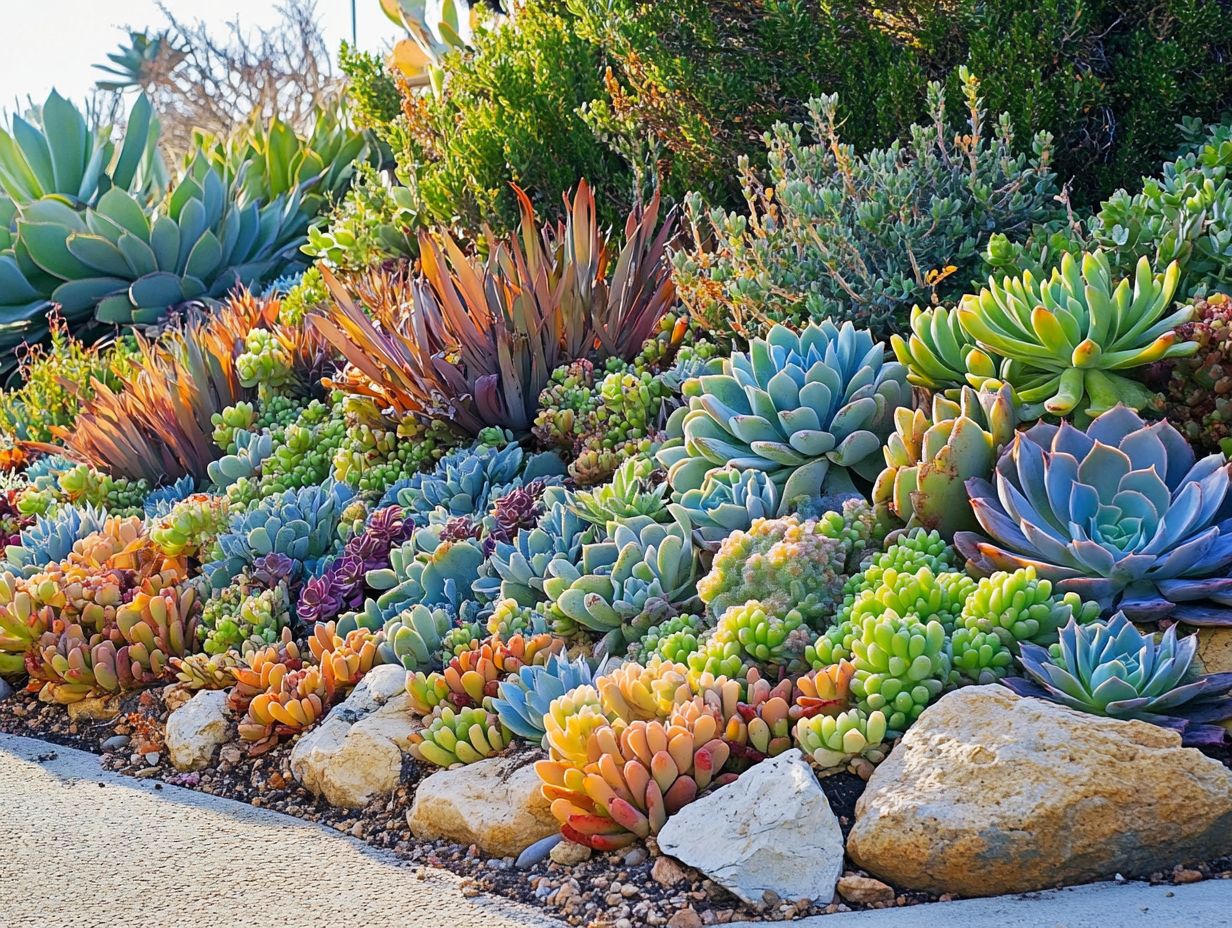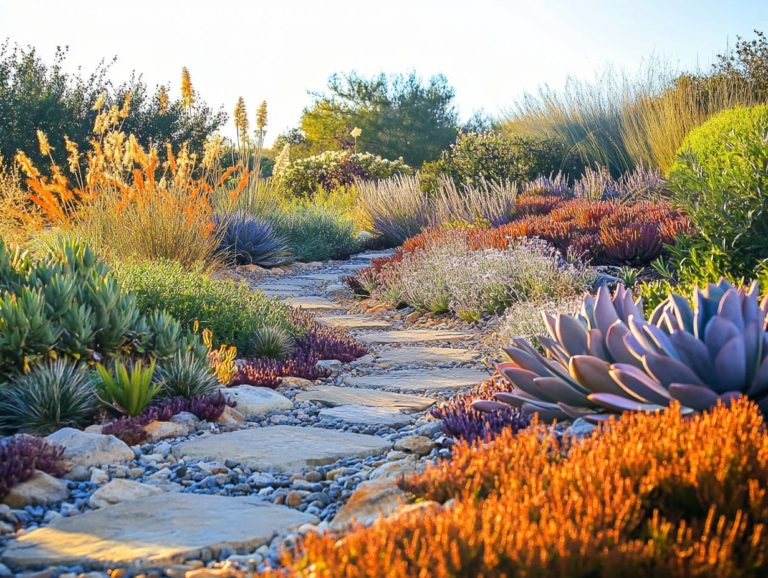Drought-Resistant Plants: Beauty Meets Function
Drought-resistant plants are more than just a smart choice for arid climates; they bring elegance and offer significant environmental benefits.
In this article, uncover what distinguishes these resilient plants, emphasizing their unique characteristics and advantages. Explore exciting drought-resistant plants that can transform your garden!
You will also find care guidelines to help these plants thrive. Get ready to transform your outdoor space into a stunning oasis!
Contents
Key Takeaways:

- Drought-resistant plants thrive in low-water conditions and have unique traits like deep root systems and water-storing leaves, ideal for drought-prone regions.
- Incorporating these plants in your garden adds beauty, helps the environment, and saves money on watering and maintenance costs.
- With many options, including native and non-native species, and proper care, you can create a beautiful and sustainable garden.
What are Drought-Resistant Plants?
Drought-resistant plants are your secret weapon for thriving in arid conditions, making them essential for gardening that s good for the environment, especially as climate change looms in our ever-changing world.
These remarkable species possess unique traits, like deep root systems and minimal water requirements, allowing them to conserve water efficiently while maintaining their charm even in tough environments.
By choosing drought-tolerant varieties, you can craft stunning landscapes that enhance your space while supporting nature’s balance. This includes unique drought-resistant plants for your home, which are critical elements for food security and resilient ecosystems in agricultural landscapes.
Definition and Characteristics
Drought-resistant plants have extraordinary traits that enable them to flourish in water-scarce environments, making them essential for eco-friendly gardening. To truly appreciate their beauty, consider the aesthetics of drought-tolerant landscapes. These species come equipped with adaptations like efficient root systems that reach deep into the soil, waxy leaves that minimize water loss, and the ability to store moisture, ensuring survival even in severe drought conditions.
Many of these resilient plants showcase specialized leaf structures, often smaller or needle-like, which reduce evaporation. Some even use a fascinating process called CAM (Crassulacean Acid Metabolism), allowing them to open their stomata during cooler nights instead of the day s heat. This amazing ability not only conserves water but also enhances their performance in arid climates.
By integrating these drought-tolerant varieties into your garden, you can support local ecosystems, reduce the need for excessive irrigation, and embrace a more sustainable approach to landscaping.
Benefits of Using Drought-Resistant Plants
Incorporating drought-resistant plants into your gardening and landscaping efforts offers numerous benefits that are both environmentally and economically advantageous, making them a wise choice for homeowners and landscape designers alike.
These resilient plants significantly reduce water usage, providing a sustainable solution to the challenges posed by climate change and drought. Understanding why choose drought-resistant plants is crucial, as they require less irrigation and maintenance, conserve essential water resources, and lower gardening costs, leading to a more manageable and efficient landscape.
Start your journey in creating a drought-resistant garden today!
Environmental and Economic Advantages
The environmental and economic benefits of drought-resistant plants make them an exceptional choice for sustainable gardening and landscaping. By significantly reducing reliance on irrigation and conserving water, these plants contribute to sustainable ecosystems and enhance soil health. They also lower gardening costs and maintenance efforts for you as a homeowner.
These resilient species do more than just survive; they foster a variety of plants and animals by providing habitats for wildlife and improving soil structure with their deep root systems. These roots prevent erosion and promote nutrient cycling. When you choose native drought-tolerant plants, you re supporting local pollinator populations while decreasing the need for man-made substances used to help plants grow.
From an economic standpoint, these choices lead to lower water bills and reduced maintenance demands. This allows you to enjoy a thriving landscape without breaking the bank. Integrating drought-resistant plants into your landscaping is a fantastic way to take care of the environment while enjoying a cost-effective, low-maintenance solution that benefits both nature and your wallet.
Types of Drought-Resistant Plants

When you explore drought-resistant plants, it s essential to differentiate between native and non-native drought-resistant species. This distinction significantly influences the variety of plants and animals in your garden.
Native drought-tolerant plants are finely attuned to local climate conditions, requiring minimal irrigation while nurturing local ecosystems. Non-native varieties might offer intriguing aesthetics, but they can occasionally disrupt established habitats.
By understanding these differences, you can make informed choices that elevate the beauty of your garden and promote sustainable gardening practices that conserve precious resources and enhance soil health.
Native vs. Non-Native Species
Choosing between native and non-native drought-resistant plants can greatly influence the health and sustainability of your garden. Native species are perfectly suited to local conditions, requiring less maintenance and irrigation. In contrast, while non-native species may have unique visual appeal, they could pose risks to local ecosystems if not managed with care.
As you make this selection, consider how each type contributes to or detracts from the variety of plants and animals. For instance, indigenous plants often attract native pollinators and wildlife, fostering a balanced ecosystem that supports crucial food chains.
Conversely, some non-native plants, despite their striking aesthetics, can take over and push out local plants, leading to a decline in native species and habitat degradation. These non-native options may demand more resources in terms of care and water, which can conflict with your sustainability goals.
Thus, it s essential to weigh these factors thoughtfully, ensuring your choices align with the local environment and promote ecological balance.
How to Incorporate Drought-Resistant Plants in Your Garden
Incorporating drought-resistant plants into your garden elevates its aesthetic appeal while embracing sustainable gardening practices that champion resource conservation.
Begin by evaluating your landscape conditions. Consider aspects like soil type, sunlight exposure, and moisture levels. This assessment will guide you in selecting the appropriate drought-tolerant species that flourish in your unique environment.
Employ design strategies that blend variety and aesthetics, ensuring that the plants harmoniously complement one another while efficiently managing water resources.
Get started today on transforming your garden with beautiful, drought-resistant plants!
Design Tips and Techniques
When designing a garden with drought-resistant plants, specific tips and techniques can significantly boost both functionality and visual appeal. For instance, integrating drought plants into landscapes involves grouping plants with similar water needs, applying organic mulch to retain moisture, and incorporating varied heights and textures to create a harmonious landscape that thrives in dry conditions while captivating the eye.
Careful plant selection is crucial for crafting a sustainable and visually pleasing environment. By opting for native species, you ensure your chosen plants are well-suited to the local soil and climate. This choice supports local wildlife and promotes biodiversity, enriching your garden’s ecosystem.
In your layout planning, emphasize the use of hardscaping elements like gravel paths or dry stream beds. These features guide rainfall and minimize runoff, optimizing moisture conservation while enhancing the overall design.
Incorporate drip irrigation systems to target specific plant needs. These systems deliver water directly to the roots, helping maintain a well-balanced garden that remains both beautiful and environmentally friendly. Enjoy a thriving outdoor space with ease.
Caring for Drought-Resistant Plants
To thrive, drought-resistant plants need specific care regarding watering, maintenance, and overall care. This allows them to flourish while minimizing resource usage and enhancing garden beauty.
Although these plants are adapted to arid conditions, they benefit significantly from proper soil management. Incorporating organic matter and mulch enhances moisture retention, ensuring they have the necessary resources.
Regularly check their condition and use smart irrigation practices to sustain their health and beauty. This ultimately fosters a more resilient garden ecosystem.
Watering Techniques

Knowing how to water and maintain drought-resistant plants is essential for cultivating a flourishing garden that conserves resources. While these plants generally need less frequent watering, the initial establishment phase calls for a more attentive approach to ensure their long-term health and survival.
To create the perfect environment for these resilient species, employ techniques like deep soaking and utilize drip irrigation systems. These methods deliver water directly to the roots while significantly reducing evaporation. Timing your watering is equally important; aim to water early in the morning or late in the evening to minimize water loss.
Don t forget about mulching around the base of your plants. This action conserves moisture and suppresses weed growth, enhancing the sustainability of your garden. Regularly monitoring soil moisture levels will help you fine-tune your watering schedule, promoting a well-balanced ecosystem that thrives on minimal resources.
Examples of Drought-Resistant Plants and Their Benefits
Explore a variety of drought-resistant plants that are easy to grow and add charm to your garden across different climates.
From vibrant succulents and robust perennials to striking shrubs and noble trees, these plants offer great options for your landscaping while promoting water conservation.
By thoughtfully selecting the right combinations, you can craft an attractive and sustainable garden that thrives even in the face of heat and drought, maximizing the benefits of your landscaping efforts.
Start crafting your drought-resistant garden today and enjoy a beautiful, low-maintenance outdoor space!
Popular and Easy-to-Grow Options
Some of the most popular and easy-to-grow options for drought-resistant plants include species like lavender, succulents, and ornamental grasses. These plants thrive on minimal water and bring stunning beauty to your garden. They help create a garden that’s good for the environment and require less maintenance, ensuring long-term food security.
Aromatic lavender flourishes in dry conditions and attracts pollinators, supporting local biodiversity and enhancing ecosystems. Succulents, with their plump leaves, excel at water storage, making them ideal for xeriscaping landscaping that reduces water use. Ornamental grasses introduce texture and movement to your garden while needing minimal irrigation, further promoting sustainability.
These varieties create a vibrant ecosystem that enhances soil health and conserves water, perfectly aligning with sustainable gardening practices. As a home gardener, you’ll discover that the benefits of native drought-resistant plants include a stunning array of colors and forms, allowing for creative planting designs that are both beautiful and eco-friendly, enhancing the overall beauty of your garden.
Frequently Asked Questions
What are drought-resistant plants?
Drought-resistant plants are able to survive in dry or arid conditions with minimal water. They have adapted to their environment by storing water, having deep roots, or possessing protective features like waxy leaves, showcasing unique characteristics.
How can drought-resistant plants benefit my garden?

Drought-resistant plants bring stunning beauty to your garden and help conserve water. By incorporating the aesthetics of drought-resistant landscaping, you can reduce your water usage and still maintain a thriving garden, contributing to sustainable landscapes.
What are some popular drought-resistant plants?
Popular drought-resistant plants include succulents, lavender, yucca, and cacti excellent examples of native plants. These plants come in various sizes, colors, and textures, making them versatile and visually appealing additions to any garden.
Do drought-resistant plants require any special care?
While drought-resistant plants are low-maintenance, they still need some care. It’s important to plant them in well-draining soil rich in organic matter and water them regularly until they are established. After that, they only need occasional watering during extended dry spells or droughts.
Can I use drought-resistant plants in any climate?
Drought-resistant plants are specifically adapted to dry conditions but can also thrive in other climates with proper care. They can withstand both hot and cold temperatures, making them suitable for various regions and conditions.
Can I use drought-resistant plants in containers or pots?
Yes, many drought-resistant plants can be grown in containers or pots. Just ensure the container has proper drainage and use a well-draining potting mix. Water the plants regularly, as container plants tend to dry out faster than those planted in the ground, especially during heat waves.






